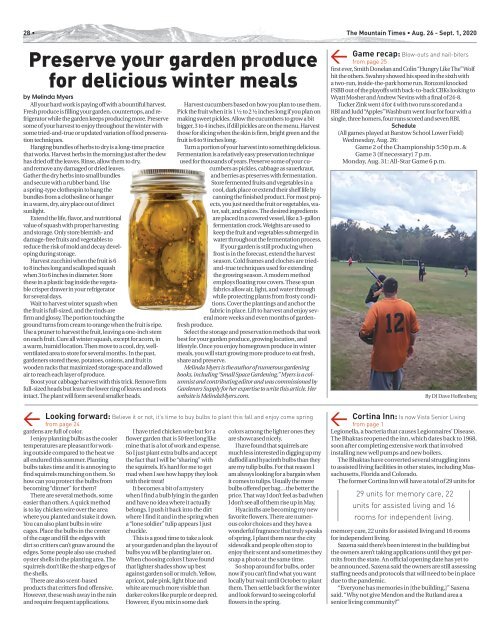Mountain Times - Volume 49, Number 35 - Aug.26-Sept.1, 2020
Create successful ePaper yourself
Turn your PDF publications into a flip-book with our unique Google optimized e-Paper software.
28 • The <strong>Mountain</strong> <strong>Times</strong> • Aug. 26 - Sept. 1, <strong>2020</strong><br />
Preserve your garden produce<br />
for delicious winter meals<br />
by Melinda Myers<br />
All your hard work is paying off with a bountiful harvest.<br />
Fresh produce is filling your garden, countertops, and refrigerator<br />
while the garden keeps producing more. Preserve<br />
some of your harvest to enjoy throughout the winter with<br />
some tried-and-true or updated variation of food preservation<br />
techniques.<br />
Hanging bundles of herbs to dry is a long-time practice<br />
that works. Harvest herbs in the morning just after the dew<br />
has dried off the leaves. Rinse, allow them to dry,<br />
and remove any damaged or dried leaves.<br />
Gather the dry herbs into small bundles<br />
and secure with a rubber band. Use<br />
a spring-type clothespin to hang the<br />
bundles from a clothesline or hanger<br />
in a warm, dry, airy place out of direct<br />
sunlight.<br />
Extend the life, flavor, and nutritional<br />
value of squash with proper harvesting<br />
and storage. Only store blemish- and<br />
damage-free fruits and vegetables to<br />
reduce the risk of mold and decay developing<br />
during storage.<br />
Harvest zucchini when the fruit is 6<br />
to 8 inches long and scalloped squash<br />
when 3 to 6 inches in diameter. Store<br />
these in a plastic bag inside the vegetable<br />
crisper drawer in your refrigerator<br />
for several days.<br />
Wait to harvest winter squash when<br />
the fruit is full-sized, and the rinds are<br />
firm and glossy. The portion touching the<br />
ground turns from cream to orange when the fruit is ripe.<br />
Use a pruner to harvest the fruit, leaving a one-inch stem<br />
on each fruit. Cure all winter squash, except for acorn, in<br />
a warm, humid location. Then move to a cool, dry, wellventilated<br />
area to store for several months. In the past,<br />
gardeners stored these, potatoes, onions, and fruit in<br />
wooden racks that maximized storage space and allowed<br />
air to reach each layer of produce.<br />
Boost your cabbage harvest with this trick. Remove firm<br />
full-sized heads but leave the lower ring of leaves and roots<br />
intact. The plant will form several smaller heads.<br />
Harvest cucumbers based on how you plan to use them.<br />
Pick the fruit when it is 1 ½ to 2 ½ inches long if you plan on<br />
making sweet pickles. Allow the cucumbers to grow a bit<br />
bigger, 3 to 4 inches, if dill pickles are on the menu. Harvest<br />
those for slicing when the skin is firm, bright green and the<br />
fruit is 6 to 9 inches long.<br />
Turn a portion of your harvest into something delicious.<br />
Fermentation is a relatively easy preservation technique<br />
used for thousands of years. Preserve some of your cucumbers<br />
as pickles, cabbage as sauerkraut,<br />
and berries as preserves with fermentation.<br />
Store fermented fruits and vegetables in a<br />
cool, dark place or extend their shelf life by<br />
canning the finished product. For most projects,<br />
you just need the fruit or vegetables, water,<br />
salt, and spices. The desired ingredients<br />
are placed in a covered vessel, like a 3-gallon<br />
fermentation crock. Weights are used to<br />
keep the fruit and vegetables submerged in<br />
water throughout the fermentation process.<br />
If your garden is still producing when<br />
frost is in the forecast, extend the harvest<br />
season. Cold frames and cloches are triedand-true<br />
techniques used for extending<br />
the growing season. A modern method<br />
employs floating row covers. These spun<br />
fabrics allow air, light, and water through<br />
while protecting plants from frosty conditions.<br />
Cover the plantings and anchor the<br />
fabric in place. Lift to harvest and enjoy several<br />
more weeks and even months of gardenfresh<br />
produce.<br />
Select the storage and preservation methods that work<br />
best for your garden produce, growing location, and<br />
lifestyle. Once you enjoy homegrown produce in winter<br />
meals, you will start growing more produce to eat fresh,<br />
share and preserve.<br />
Melinda Myers is the author of numerous gardening<br />
books, including “Small Space Gardening.” Myers is a columnist<br />
and contributing editor and was commissioned by<br />
Gardeners Supply for her expertise to write this article. Her<br />
website is MelindaMyers.com.<br />
Game recap: Blow-outs and nail-biters<br />
><br />
from page 25<br />
first ever, Smith Donelan and Colin “Hungry Like The” Wolf<br />
hit the others. Swahny showed his speed in the sixth with<br />
a two-run, inside-the-park home run. Ronzoni knocked<br />
FSBB out of the playoffs with back-to-back CBKs looking to<br />
Wyatt Mosher and Andrew Nevins with a final of 24-8.<br />
Tucker Zink went 4 for 4 with two runs scored and a<br />
RBI and Judd “Apples” Washburn went four for four with a<br />
single, three homers, four runs scored and seven RBI.<br />
Schedule<br />
(All games played at Barstow School Lower Field)<br />
Wednesday, Aug. 26:<br />
Game 2 of the Championship 5:50 p.m. &<br />
Game 3 (if necessary) 7 p.m.<br />
Monday, Aug. 31: All-Star Game 6 p.m.<br />
By DJ Dave Hoffenberg<br />
Looking forward: Believe it or not, it’s time to buy bulbs to plant this fall and enjoy come spring<br />
><br />
from page 24<br />
gardens are full of color.<br />
I enjoy planting bulbs as the cooler<br />
temperatures are pleasant for working<br />
outside compared to the heat we<br />
all endured this summer. Planting<br />
bulbs takes time and it is annoying to<br />
find squirrels munching on them. So<br />
how can you protect the bulbs from<br />
becoming “dinner” for them?<br />
There are several methods, some<br />
easier than others. A quick method<br />
is to lay chicken wire over the area<br />
where you planted and stake it down.<br />
You can also plant bulbs in wire<br />
cages. Place the bulbs in the center<br />
of the cage and fill the edges with<br />
dirt so critters can’t gnaw around the<br />
edges. Some people also use crushed<br />
oyster shells in the planting area. The<br />
squirrels don’t like the sharp edges of<br />
the shells.<br />
There are also scent-based<br />
products that critters find offensive.<br />
However, these wash away in the rain<br />
and require frequent applications.<br />
I have tried chicken wire but for a<br />
flower garden that is 50 feet long like<br />
mine that is a lot of work and expense.<br />
So I just plant extra bulbs and accept<br />
the fact that I will be “sharing” with<br />
the squirrels. It’s hard for me to get<br />
mad when I see how happy they look<br />
with their treat!<br />
It becomes a bit of a mystery<br />
when I find a bulb lying in the garden<br />
and have no idea where it actually<br />
belongs. I push it back into the dirt<br />
where I find it and in the spring when<br />
a “lone soldier” tulip appears I just<br />
chuckle.<br />
This is a good time to take a look<br />
at your garden and plan the layout of<br />
bulbs you will be planting later on.<br />
When choosing colors I have found<br />
that lighter shades show up best<br />
against garden soil or mulch. Yellow,<br />
apricot, pale pink, light blue and<br />
white are much more visible than<br />
darker colors like purple or deep red.<br />
However, if you mix in some dark<br />
colors among the lighter ones they<br />
are showcased nicely.<br />
I have found that squirrels are<br />
much less interested in digging up my<br />
daffodil and hyacinth bulbs than they<br />
are my tulip bulbs. For that reason I<br />
am always looking for a bargain when<br />
it comes to tulips. Usually the more<br />
bulbs offered per bag…the better the<br />
price. That way I don’t feel as bad when<br />
I don’t see all of them rise up in May.<br />
Hyacinths are becoming my new<br />
favorite flowers. There are numerous<br />
color choices and they have a<br />
wonderful fragrance that truly speaks<br />
of spring. I plant them near the city<br />
sidewalk and people often stop to<br />
enjoy their scent and sometimes they<br />
snap a photo at the same time.<br />
So shop around for bulbs, order<br />
now if you can’t find what you want<br />
locally but wait until October to plant<br />
them. Then settle back for the winter<br />
and look forward to seeing colorful<br />
flowers in the spring.<br />
><br />
Cortina Inn: Is now Vista Senior Living<br />
from page 1<br />
Legionella, a bacteria that causes Legionnaires’ Disease.<br />
The Bhaktas reopened the inn, which dates back to 1968,<br />
soon after completing extensive work that involved<br />
installing new well pumps and new boilers.<br />
The Bhaktas have converted several struggling inns<br />
to assisted living facilities in other states, including Massachusetts,<br />
Florida and Colorado.<br />
The former Cortina Inn will have a total of 29 units for<br />
29 units for memory care, 22<br />
units for assisted living and 16<br />
rooms for independent living.<br />
memory care, 22 units for assisted living and 16 rooms<br />
for independent living.<br />
Saxena said there’s been interest in the building but<br />
the owners aren’t taking applications until they get permits<br />
from the state. An official opening date has yet to<br />
be announced. Saxena said the owners are still assessing<br />
staffing needs and protocols that will need to be in place<br />
due to the pandemic.<br />
“Everyone has memories in [the building,]” Saxena<br />
said. “Why not give Mendon and the Rutland area a<br />
senior living community?”

















